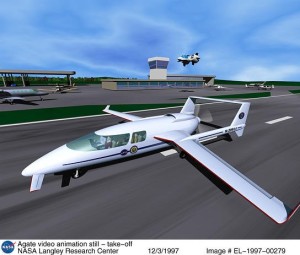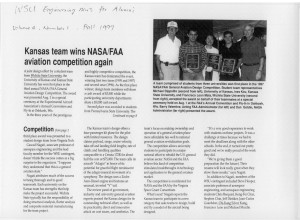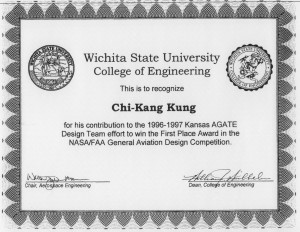1996 年 9 月 到 1997 年 6 月是我人生中最難忘的一段時間之一。在 Wichita State University 航太系最後一年,與一群來自全世界各地的精英組成的 Kansas Design Team,以參加 NASA/FAA 舉辦的一年一度 AGATE 飛機設計比賽當作是我們的畢業論文。來自台灣的我,委內瑞拉的 Francisco,美國的 Chris,瑞典的 Michael,西班牙的 Carlos等人。常常在 NIAR 國家航空實驗室我們專屬的研究室裡熬夜到天亮,大家輪流下去樓下的販賣機買 Mountain Dew,補充能量。還記得有一次得去 University of Kansas 做簡報,那天整晚大家都沒睡,好不容易做完的投影片突然電腦當機~ 硬著頭皮馬上重做,然後一路開 240 公里時速飆去 Lawrence (WSU 到 KU 正常開車要 2.5 個小時),差幾分鐘趕上簡報。最後一天六七百頁的報告送出去了,大家去 pub 喝到爛醉!之後大家各飛東西 (天哪,是真的各飛東西啊!)
1997 年 8 月 1 號,我已經搬到 紐約了,準備開始我的大轉行 (從航太工程師轉成財務工程師),Francisco 代表我們大家去頒獎典禮現場,確認我們拿到全國第一名的時候,真是不敢相信啊!全美國 192 間有航太系的大學,我們拿到了第一名!最後 NASA 發給我的獎金支票,一直捨不得去兌現。這是我人生的一大記錄。這過程中,也讓我經歷了整個創業人生的縮影!再怎麼樣的困難也難不倒我的! 


NASA 的網站上面也有這一則報導的記錄:
http://www.nasa.gov/centers/langley/news/releases/1997/Aug97/97_79.html
For Release: August 1, 1997 Dwayne Brown Headquarters, Washington, DC 202/358-1726 Keith Henry Langley Research Center 757/864-6120 Mary Sandy Virginia Space Grant Consortium 757/865-0726 RELEASE NO. 97-079 TEAM OF KANSAS UNIVERSITIES TAKES FIRST PLACE IN NASA/FAA GENERAL AVIATION DESIGN COMPETITION A joint design effort by student teams from three Kansas universities took first place in the 1997 NASA/FAA General Aviation Design Competition. The schools teaming for this design are University of Kansas, Lawrence; Wichita State University, Wichita; and Kansas State University, Manhattan and Salina campuses. The award was presented today in a special ceremony at the Experimental Aircraft Association’s Annual Convention and Fly-In at Oshkosh, Wisc. NASA Administrator Dan Goldin and FAA Acting Administrator Barry Valentine presented the awards. The national competition seeks to involve university student teams from U.S. engineering schools in the revitalization of the general aviation sector. Revitalization goals present open-ended design challenges that stimulate engineering students and provide the basis for a quality educational experience, while helping students understand the economic relevance of general aviation. Teams were asked to address design challenges in one or more of the following technical areas: Integrated cockpit systems; propulsion; noise and emissions; integrated design and manufacturing; aerodynamics; operating infrastructure and new designs such as air-cars. Students may consider designs for an entire aircraft or for a system or subsystem. The competition, in its third year, allows university students to participate in a major national effort to rebuild the U.S. general aviation sector. For the purpose of the contest, general aviation aircraft are defined as single-pilot, fixed-wing, single-engine, propeller-driven aircraft for 2-6 passengers. Teams of undergraduate and graduate students from U.S. engineering schools work with faculty advisors to address design challenges for a small aircraft transportation system. The competition seeks to raise student awareness of the value of general aviation for business and personal use while promoting an understanding of its economic relevance. NASA and the FAA believe that this kind of competition serves to stimulate breakthroughs in technology and their application in the general aviation market. The Kansas team design offers a four-passenger, kit plane “for the pilot with limited resources.” The design claims payload, range, cruise velocity, take-off and landing field lengths, rate of climb, and handling qualities comparable to a Cessna 172R for about half the cost or $75,000. The team calls its aircraft “Adagio” in honor of its potential for graceful flight reminiscent of the adagio musical movement of a symphony. The design uses a Zoche Aero-Diesel engine and features an unusual, inverted “V” tail. The team cited that most kit planes are sold with the understanding that the owners will spend about 1,500 hours building the kit plane. The Adagio would require only 200 hours because of the use of pre-assembled/pre-fabricated structures. The use of these structures would require a new interpretation of FAA’s rule which requires an owner to build and/or fabricate at least 50% of a kit-type plane. This is the second time the Kansas team has garnered the first place award in this prestigious and highly competitive competition. In 1996, the team won second place. The review panel of government, industry and university general aviation experts praised the Kansas design for its outstanding technical effort, as well as its practicality, direct and innovative attack on cost issues, and aesthetics. The team’s focus on making ownership and operation of a general aviation plane more affordable ties well to national general aviation revitalization goals. As first place winners, design team members will share a cash award of $3,000 while the University of Kansas and Wichita State University Aerospace Engineering Departments and the Kansas State University Mechanical Engineering Department will share a $5,000 cash award. The competition is coordinated for NASA and the FAA by the Virginia Space Grant Consortium. Guidelines for the fourth annual competition, to be held during the 1997-1998 academic year, will be available from the Consortium in August at 757/865-0726 or from msandy@pen.k12.va.us.
